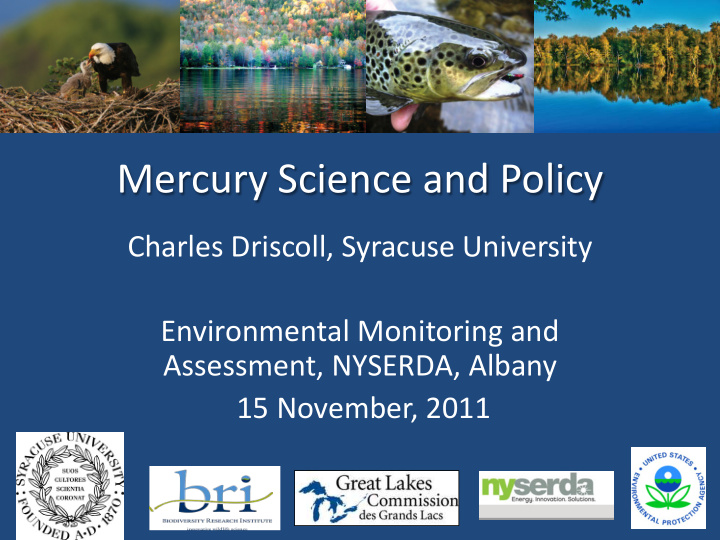



Mercury Science and Policy Charles Driscoll, Syracuse University Environmental Monitoring and Assessment, NYSERDA, Albany 15 November, 2011
Outline 1. Background on Mercury and U.S. Patterns 2. Study of Great Lakes Region – Emissions and deposition – Fish mercury & risks – Wildlife mercury 3. Mercury Policy 4. Take Home Messages and Research Needs
Mercury in the Environment
Sunderland et al ., in prep., based on Holmes et al., 2010; Soerensen et al. , 2010; Smith-Downey et al ., 2010 and Sunderland and Mason, 2007
Watershed Hg Sensitivity 5
Note: as supplied by Anne Pope, OAQPS on 9/30/09
Fish Mercury across the U.S. Derived from Wente, S. 2004
Fish Advisories for Mercury are Everywhere Source: EPA website http://water.epa.gov/scitech/swguidance/fishshellfish/fishadvisories/upload/ 2009_09_22_fish_advisories_nlfaslides.pdf
9 Background • 35 papers in 2 special issues: Ecotoxicology, Environmental Pollution • 170+ scientists and managers • >300,000 measurements • Supported by Great Lakes Commission EPA- funded Great Lake Air Deposition (GLAD) program
Forest, shrubland Cropland , grassland, barren Urban Water Wetland 500 M iles
Emissions Exceed Deposition of Mercury for the Great Lakes Basin, and the Region is a Net Mercury Sink 25 Input Losses Emissions Deposition 20 litter 200 km 2 -yr) buffer dry Mercury Flux ( g/m reduced basin 15 reduced 10 evasion wet oxidized 5 oxidized runoff 0 Emissions in the broader GL region are high (26% of total US/Canada emissions) and include a high percentage of oxidized Hg (46%).
Mercury in Selected Fishes Evers et al . 2011.
Mercury in Game Fish Evers et al . 2011 based on Zanaski et al . and Monson et al . 2011.
14 Mercury and Walleye Health Evers et al. 2011 based on Sandheinrich et al. 2011.
Mercury in Great Lakes Wildlife
Literature Accounts of Affected Species Evers et al. 2011.
Mercury Trends – Lake Sediments N = 91 lakes Drevnick et al. 2011.
U.S. Great Lakes States Emissions U.S. Emissions U.S. Emissions Global Emissions Evers et al. 2011.
Mercury Trends - Fish Red line = 0.3 ppm – EPA human health criterion Monson et al. 2011, Zananski et al. 2011
Mercury Policies Maximum Achievable Control Technology Clean Air Act Section 112 The maximum degree of emissions reduction achievable taking into consideration cost, any non-air quality health and environmental impacts and energy requirements. • For existing facilities: – No less stringent than the average emissions limit achieved by the best performing 12% of the sources. • For new facilities: – No less stringent than the emissions limit achieved by the best controlled existing source.
US Mercury Emission Policy Timeline TRAIN ACT 1990 EPA CAAA Regulatory HAP Reform Act 2000 2011 MACT Power 2005 Utility Air Incineration CAMR Plant Toxics Rule Controls HAP MACT 2008 CAMR Vacated State (17) 25 states Rules MACT 2008 Rule ~ ~ Intergovernmental Congress EPA Courts Negotiating Committee States UNEP
Policy Drivers Upcoming MACT Standards for Sources of Mercury
MercNet Provides Comprehensive Geographical Coverage • Baseline data and infrastructure • Will we see and be able to understand a change? • Model evaluation • Want a range of site types • Global source impacts • Collaboration w/Nat. networks (NADP, LTER, CASTNET, NEON )
Take Home Messages 1. Mercury contamination is more extensive and severe than previously documented. 2. Past mercury controls have been beneficial but mercury in fish and wildlife continue to exceed ecological and human health risk thresholds. 3. Further decreases in mercury emissions from US sources would have additional benefits, roughly in proportion to level of declines. 4. A comprehensive mercury monitoring system would help evaluate trends and effectiveness of policy decisions.
Research Needs • Multi-media monitoring of mercury in air, deposition, ecosystem components and biota. • Improved models to understand and predict the fate and effects of changes in mercury deposition. 25
Acknowledgements • Kathy Lambert, David Schmeltz, Elsie Sunderland, Dave Evers, Jim Weiner, Madeline Turnquist, Kim Driscoll, Maureen Hale • NYSERDA, U.S.EPA GLAD
Recommend
More recommend